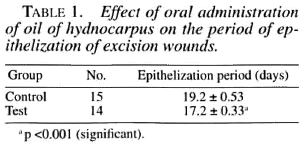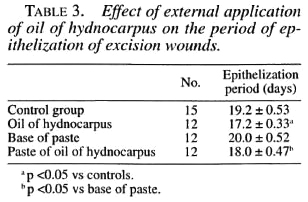- Volume 68 , Number 1
- Page: 69–70
The effect of oil of hydnocarpus on excision wounds
To the Editor:
Subsequent to our report on the effect of the oil of hydnocarpus on wound healing in which we used the incision wound model and the dead space model (3), further studies were done on male rats of the Wistar strain using the excision wound model. In this model a round seal 2.5 cm in diameter is impressed upon the shaven portion of the skin 5 cm away from the cars of the anesthetized animal. A full-thickness skin excision is taken from the marked area as described b y Morton and Malone (2). After achieving complete hemostasis, the animals are housed in individual cages and given food and water ad libidum.
The excision wound model is a good design to study the phases of wound contraction and epithelization. Wound contraction is characterized by a centripetal movement of the whole thickness of the surrounding skin (4). Since the subcutaneous layer of panniculus carneosus which is seen in animals is not seen in humans, the wound contraction is more significant in humans when it leads to distortion and immobilization in some areas because of the tension which develops through the attachment of the integument to the underlying structures. Wound contraction and epithelization are independent processes and are also independent of collagen synthesis and new tissue formation (1).
Wound contraction, which mainly contributes to the wound closure in the first 2 weeks, is studied by tracing the raw wound area on butter paper every alternate day for 18 days. The tracings are then retraced on graph paper to calculate the area of wound contraction, which is calculated as a percentage of the original wound. The falling of the scab leaving no raw area is taken as the end point of complete epithelization, and the time taken for the scab to fall off is taken as the period of epithelization.
To study the effect of the oral administration of the oil of hydnocarpus, two groups of 15 animals each were used, one of which served as the control. The dosage used was the same as for our previous studies (3). To study the effect of the external application of the oil, four groups of animals were used: Group 1 (N =15) served as controls; to Group 2 (N = 12) oil of hydnocarpus was applied topically; to Group 3 (N = 12) the base of the hydnocarpus ointment was applied topically, and to Group 4 (N = 12) hydnocarpus ointment was applied topically.
We observed that in the group receiving the drug orally the period of epithelization was promoted significantly (p <0.00 1, Tables 1 and 2), but the wound contraction was not altered. External application of oil of hydnocarpus and its paste significantly shortened the epithelization period when compared with the control group and the group receiving the base of the ointment, respectively (p <0.005, Tables 3 and 4). Neither the oil nor its paste when applied externally altered the wound contraction.




We conclude that in the excision wound model oil of hydnocarpus when applied topically (either alone or in the form of a paste) or when administered orally promoted epithelization without affecting wound contraction. This compares well with our previous observation on the incision and dead space models (3). It follows, therefore, that apart from promoting collagenation (3) the oil of hydnocarpus also promotes epithelization in excision wounds, and it could, therefore, be a useful adjunct in the management of plantar ulcers or other open wounds in leprosy patients.
S. T. Oommen, B.Sc, M.D.
Father Midler's Medical College
Fr. Midler Road
Kaukanady
Mangalore 575 002, India
REFERENCES
1. ABERCOMBE, M., NECOMBE, J. F. and JANUS, D. W. Wound contraction in rabbit skin studies by supplying the wound margin. J. Anat. 94 (1960) 170-171.
2. MORTON, J. J. P. and MALONE, M. H. Evaluation of vulnerary activity by an open wound procedure in rats. Arch. Int. Pharmacodyn. 180 (1972) 659-665.
3. OOMMEN, S. T, RAO, C. M. and RAJU, C. V. N. Effect of oil of hydnocarpus on wound healing. Int. J. Lepr. 67(1999) 154-158.
4. PEACOCK, E. E. Wound contraction. In: Principles of Surgery. 4th edn. Schwartz, S. I., Shires, G. T, Spenser, F. C, Stores, E. H., eds. New York: Mc-Graw Hill Int. Books Co., Asian Student Edn., 1984, pp. 289-311.